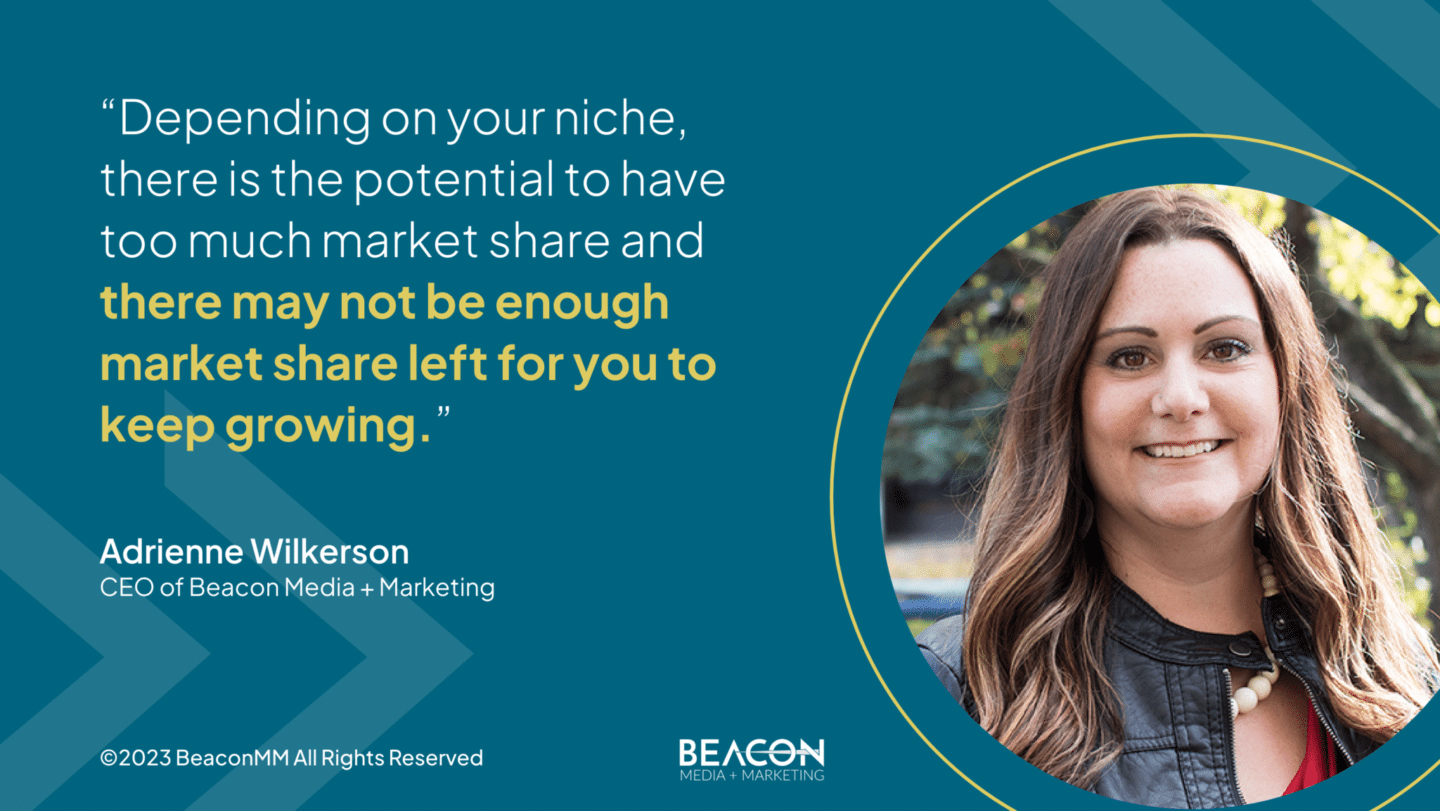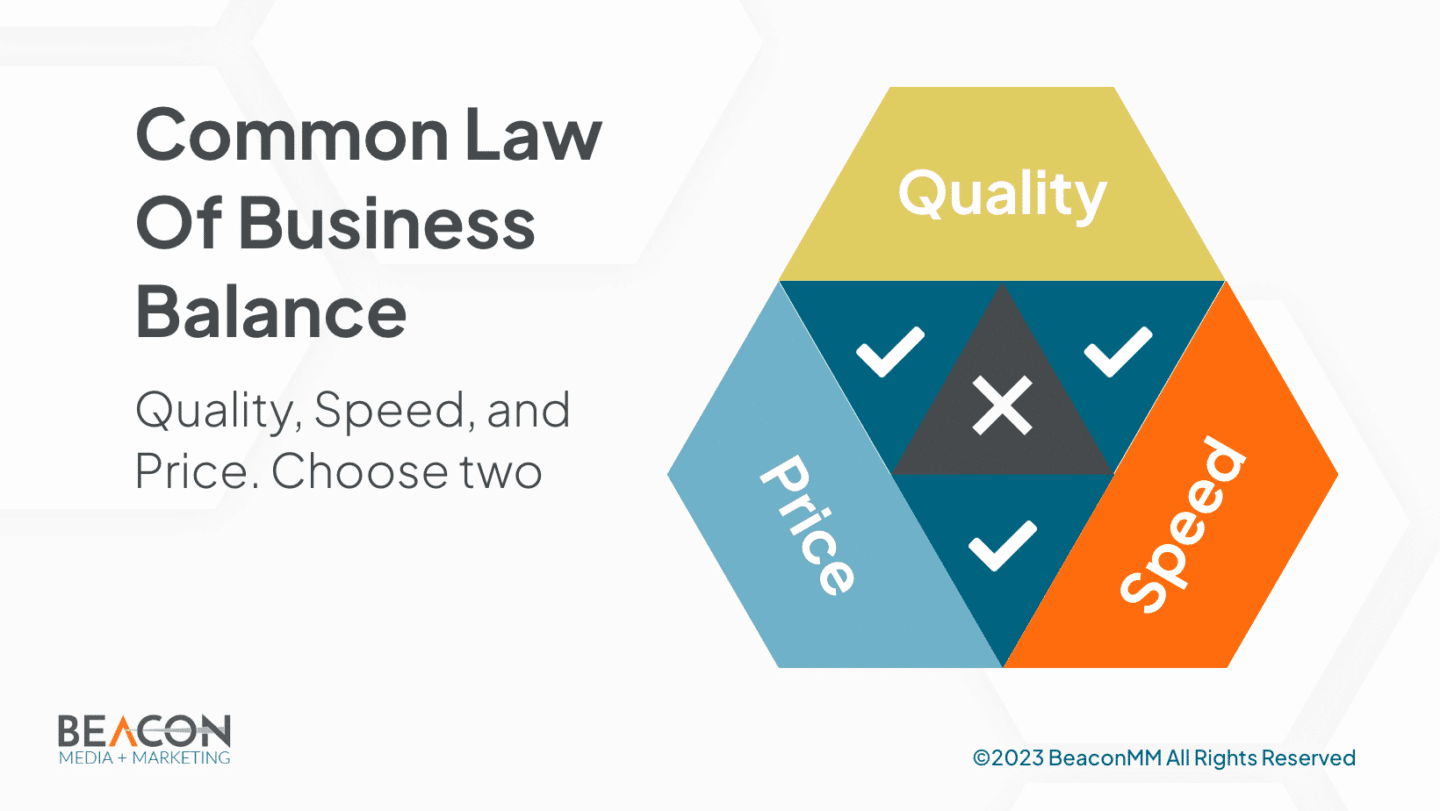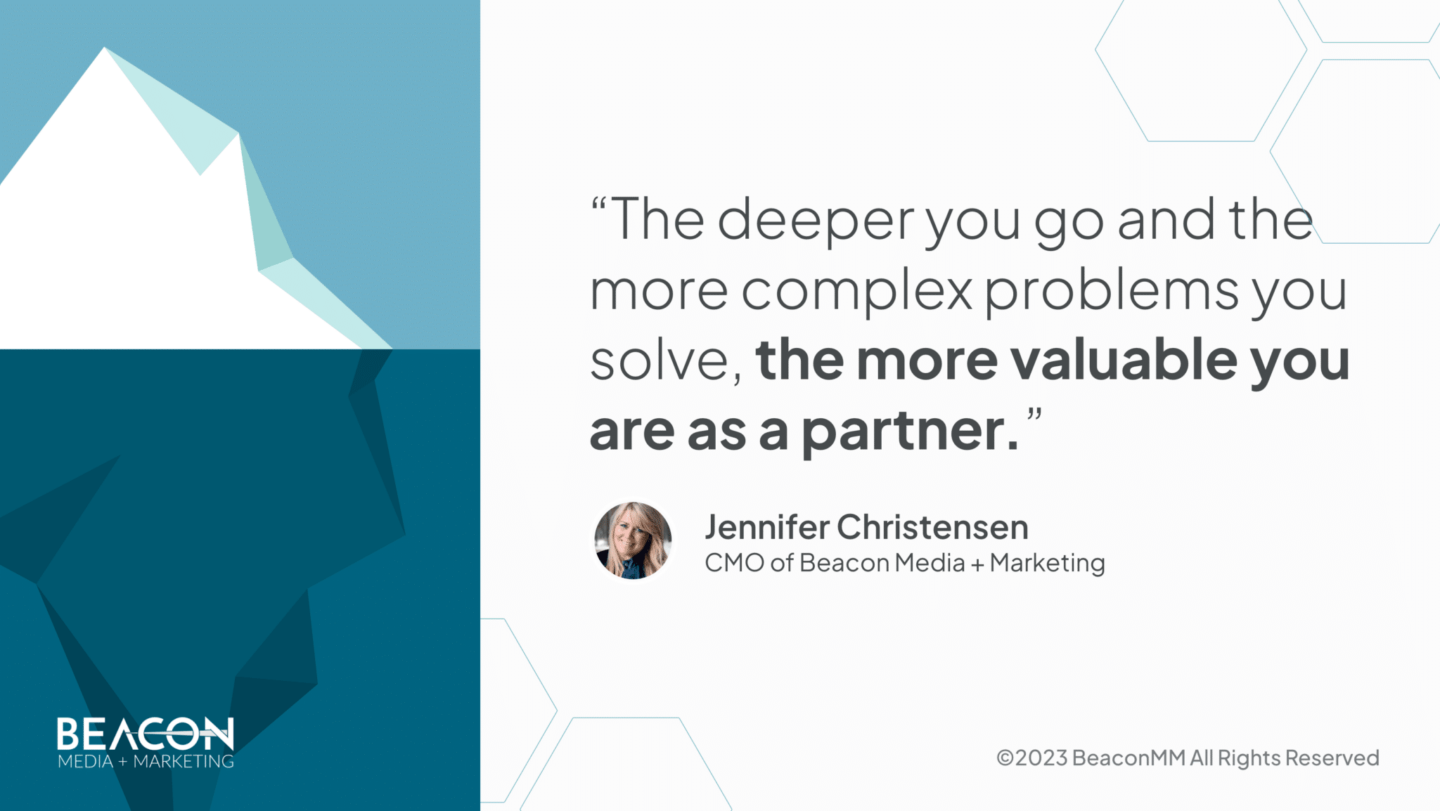How Business Development Can Fuel Growth

Business Growth means many things to many people and determining how your business should grow takes time and strategy. Making a business development plan should include the pain points you are solving for your target market and how you will balance the quality, price, and speed triangle.
In our previous blog, Brand Messaging Part Two, we discussed how Beacon Media + Marketing helps our clients identify pain points, the impetus behind the start of the business, unique services to solve a problem in the desired market, and how finding a niche is a great way to attract potential clients in the right target market.
It is not only important to be clear on your services but also to find the balance between how those services will be delivered to clients. You must find balance in the triangle of quality, price, and speed.
Beacon Media + Marketing started out as a digital marketing agency at a time when that was basically unheard of in Anchorage, AK. At the time, it was important for us to look at all our business opportunities and recognize that our target audience wasn’t familiar with our work because we were offering an unknown product. While our innovative ideas would add long-term value to our clients, we had to compromise on price in those early adoption days.
We’ve talked to many business owners over the years and have yet to find one who has mastered the whole triangle. You can have any combination of one or two but effective business development doesn’t lend to having all three.
Navigating the Nuance of Pain Points and Problem-Solving
In business development efforts, it’s easy to confuse pain points with problem-solving. The customer’s pain point is the problem and that is what they want you to solve. Understanding how you are solving that for the customer is pivotal to your own business development plan.
Consider the growth opportunities in front of you as you ask yourself, “How is my business addressing the problem?” Communication of your product or service to your potential customers is a core piece of your marketing message.
When the relationship between pain points and problem-solving is truly understood, businesses can move forward with strategic marketing tools to flood the brand messaging into all the parts of the marketing and sales funnel.
The Downside of Problem Solving: Creating More Problems
Your business’ product or service may be a stellar offering for your market — just be aware that your potential customer’s problem to solve may be more complex than you anticipated.
Potential customers know that they need a service that they are unable to provide themselves in order to get qualified leads and achieve business growth. Solving the problem with your knowledge is one thing, but will that be the best long-term value for them? Maybe or, maybe not.
The best business strategy may be thinking in broader strokes and building strong relationships with your customers by offering a more in-depth approach. It may not be as fast as other solutions, but it will be quality and offer longevity. Just following fast-moving industry trends is not always the best answer.
When clients were onboarding with Beacon, we often needed five to ten hours a month of their time to extract the information from their business to put online. This can be a frustrating experience for your client when they hired you to take this burden off of them. Additionally, they may not have the answers to your questions.
Going deep and asking probing questions to uncover the depth of what the core problem is that they need you to solve is important. At the end of the day, the core problem may not be expertise, knowledge, desire, or talent. It may be time.
If you are costing them as much time as it would take for them to solve this problem for themselves, you’re most likely not creating lasting business relationships.
Building strategic partnerships with your customers means slowing down and going deep enough with them to identify all their pain points, not just the ones on the surface. It means rendering a service that will help alleviate the pain instead of exacerbating it.
Optimize Growth by Streamlining the Process for Success
A few ways to form strategic partnerships with your customer base are to remove barriers and streamline processes so that they feel the marketing team is a help and not a hindrance to successful business development.
Your customer may not ever arrive at a place where they enjoy the process of you solving their problem. However, trust can be created between them and the marketing team when going through the deep-dive questions. These are the times when you uncover the problem past the articulated pain point.
Explore Beyond The Business to a Holistic Understanding of the Problems You Address
As CMO of Beacon Media + Marketing, Jennifer Christensen knows that diving into questions outside of the business box really helps her incorporate new business opportunities and niche down to the current pain point that she is solving.
Consider adding this approach to your marketing skills when communicating with your clients. Gaining knowledge about their relationship to their business, their vendors, and their life, in general, can give you a competitive advantage and provide for other areas of opportunities to problem solve.
Being a great partner can mean the difference between having successful sales and the implementation of growth opportunities for both of you. Your client may not know that your business has more to offer them than what they initially signed on for.
Understanding the Competition: A Strategic Competitive Advantage
Knowing what others in your field of product or service are offering is a great way to stay up on industry trends. We’re not saying that you need to implement the same growth opportunities that others are, we are saying that it is massively important to know what others are doing.
Understanding the competition and setting yourself apart from them is another great competitive advantage for your company. It will help you niche down further into your target audience and provide you with a business development strategy for your future.
Setting business development goals based on the competition can help you solve specific problems past the pain points of your customers. We do not advise that your business development is based entirely on what your competition is and is not doing, however. Your business has to be unique to you and to your values.
Establishing yourself as a unique company in your industry will bring you light years ahead of your competition, especially if you’re trying to break into a well-established industry. Having that unique position is essential to business growth.
We recommend that you make time to recognize who the big players are for your target audience and secret shop them. Take notes on what they are doing well, what they are not doing, who has been around a long time, and who is new.
Business development can take up so much of your focus that you get trapped inside your own little bubble and it’s easy to forget just how many options are out there for your potential clients. Competition isn’t bad, it poses an opportunity for your business to be clear about your unique position in the market and focus on how you can solve problems better or faster or deeper than the competition.
It is important to understand that the competition is vast for qualified leads. If you aren’t clear about what your unique position is and how you solve problems better or faster or deeper than the competition, then ultimately you’re just a few steps away from losing that client.
Navigating the Quality, Speed, and Price Triangle for Successful Business Development Strategy

The consumer marketplace is flooded with products or services with new innovations coming out every day. These products or services are not all quality products delivered fast and cheaply.
What product you would consider a status symbol, is it cheap or is it a quality product? Assumption can be made that if it’s a status symbol to you then you wouldn’t expect to get it fast or cheap and that the quality is going to be top-notch.
The same can be said about your product or service. As a business owner who is developing your business model, it’s important to ask and clearly identify, “What category of product do you want your company’s reputation to be known for?”
If quality is number one in your business development plan because you are offering a high-end product, then your target audience won’t expect to get your services for low prices. If you can produce a high-end product or service quickly, then you’ll make a huge impression on your clients and puts you in the position of showing that you are a great business partner.
High-end restaurants will do this to produce a high-end dish that takes time to prepare. It’s communicated ahead of time that the dish is unique and possesses quality ingredients so it will take longer to prepare. The dinner came to that restaurant and knew to expect a higher-end price tag, if they choose that entree, they are also choosing to accept the longer waiting period to enjoy the dish.
This above example shows that as a business owner, you can achieve two parts of the Price Triangle but not all three. Achieving better business development is a challenge when trying to go for the widest range possible and to reach a larger target audience with a full menu of products or services. Again, this is why we encourage the strategic business decisions of niching down and choosing which part or parts of the Price Triangle to focus on.
Fast-food popularity is another fabulous example of how two of the three areas of the Price Triangle can complement each other, with price and speed being valued above quality.
Achieving Flexibility in Business: Balancing Quality, Speed, and Price
When Beacon Media + Marketing began to fully immerse ourselves in our niche of Digital Marketing, we had to sacrifice price in order to establish a level of value and proof of concept in the unknown market in Anchorage, AK.
Over time, we increased our prices because our product was producing a tremendous value to our clients and we also embraced the speed component that our industry demands. Our quality and speed spoke for themselves when it came to client value.
Airbnb is a great example of flexibility in the triangle. When they came to market with their unique concept, they were quite a bit less expensive than the alternative of hotel and resort stays, and their target audience was really excited about that.
Once they established their space in the marketplace, the opportunity to shift in the triangle became available. They have not stayed with the focus of pricing less but have moved in the opposite direction to high-quality, unique stay experiences.
Morphing over time from where you started is not a bad thing, developing new business standards and pricing is helpful to move your business forward to where it needs to go to grow.
You can’t make everyone happy all the time, so for us at Beacon, we have found that focusing on two main points is our sweet spot. When we left those ideals and tried for three, we crashed and burned. The outcome of which caused us to work too many hours and that was not sustainable long-term.
Strategic Development vs Reactive Development: How To Lead Your Sales Teams
Price thresholds have been a new business implementation at Beacon. We came to know that there was a minimum budget that our potential customers would have to have in order for us to provide them with optimal services and enable us to convert them into clients. We value being able to produce a quality product or service and in order to do that, there is a specific budget that requires.
We have also found that by niching down into our optimal target audience of industries we serve, we can actually look at bringing in other lower-priced options. We know that is not our core clientele but we can offer it as an option for certain start-up situations that serves as a stepping stone for smaller providers and it still aligns with our values which is to help people Grow, Scale, and Thrive.
By developing something that stayed true to our brand, but also serves our smaller clients, we also had to establish with them that the level of service will not be as if they had the full-priced option. Communication of expectations is critical and essential to being a good business partner and developing strong business relationships.
Quality or Quantity, that is the Question!
As you’re working on your business development strategy, a crucial decision you’ll need to make is, do you want to make money out of quality or quantity.
This is where your brand identity comes into play, what kind of company do you want to be? What is your company identity? Are you a company whose business development strategy is to churn out more widgets than anyone else in an eight-hour period but those widgets have a shorter life span than the competition is offering? Or are you a company that wants to focus on longer-lasting products for your potential partners? Neither of these options is good or bad because there is room for both in the market.
Either way, new leads, and sales targets will have the opportunity to choose from the product or service you are offering. They decide if they want fast or longevity from your service. Your marketing functions will be born out of this decision and it is imperative that you are clear about what you offer.
Adjust Your Brand to Cater to Multiple Markets
Whichever avenue you choose, you also have the option to expand your product and services in your business development strategy to include both high-end and lower or average-priced offerings.
The fashion industry has many examples of this, Donna Karan has done this masterfully. The high-end designer market brand was a small niche market, by adding to her line DKNY, she was able to expand her reach into a greater market of the average consumer.
The shift was not without risk. Her business development strategy had to include the ability to not dilute her main brand while sacrificing the quality that her high-end products were known for. For this adjustment, the price was the portion of the Price Triangle that became the focus but also was sacrificed along with quality.
Deciding how to reach a bigger market while maintaining brand standards but making adjustments to price for a new target audience should include market analysis with a solid business development strategy.
Be Aware: Innovate but Analyze the Market Share

While we recommend niching down in your market, one thing to be aware of as you niche down is to understand that there is the potential to have too much market share. Additionally, there may not be enough market share left for you to keep growing.
Competition is inevitable. Because of this, we recommend that you continue to look around for those who may be nipping at your heels in order to take market shares from you. Innovation is one way to combat a dwindling market share.
Looking into other markets for new opportunities and creating complementary brands for those new markets was the secret to the success of the Donna Karan to DKNY brand transition.
Brand Messaging and Business Development: Closely Tied Strategic Partners
Brand messaging has so much to do with business development. When setting your business up for success, we recommend that you never lose sight of who you are as a brand and really marry the two strategically.
The multiple layers of brand messaging have to be considered holistically and are the foundation of your whole business development process. As you launch, flex, and shape your business, solving pain points, offering unique services and finding your brand voice are important elements. Combined, they will help you reach your target audience and gain strategic partnerships with your clients.
For our whole Brand Messaging series, check out our podcast, The Beacon Way. You can find the links to those specific episodes here. (Episode 8, Episode 9, Episode 10, Episode 11).